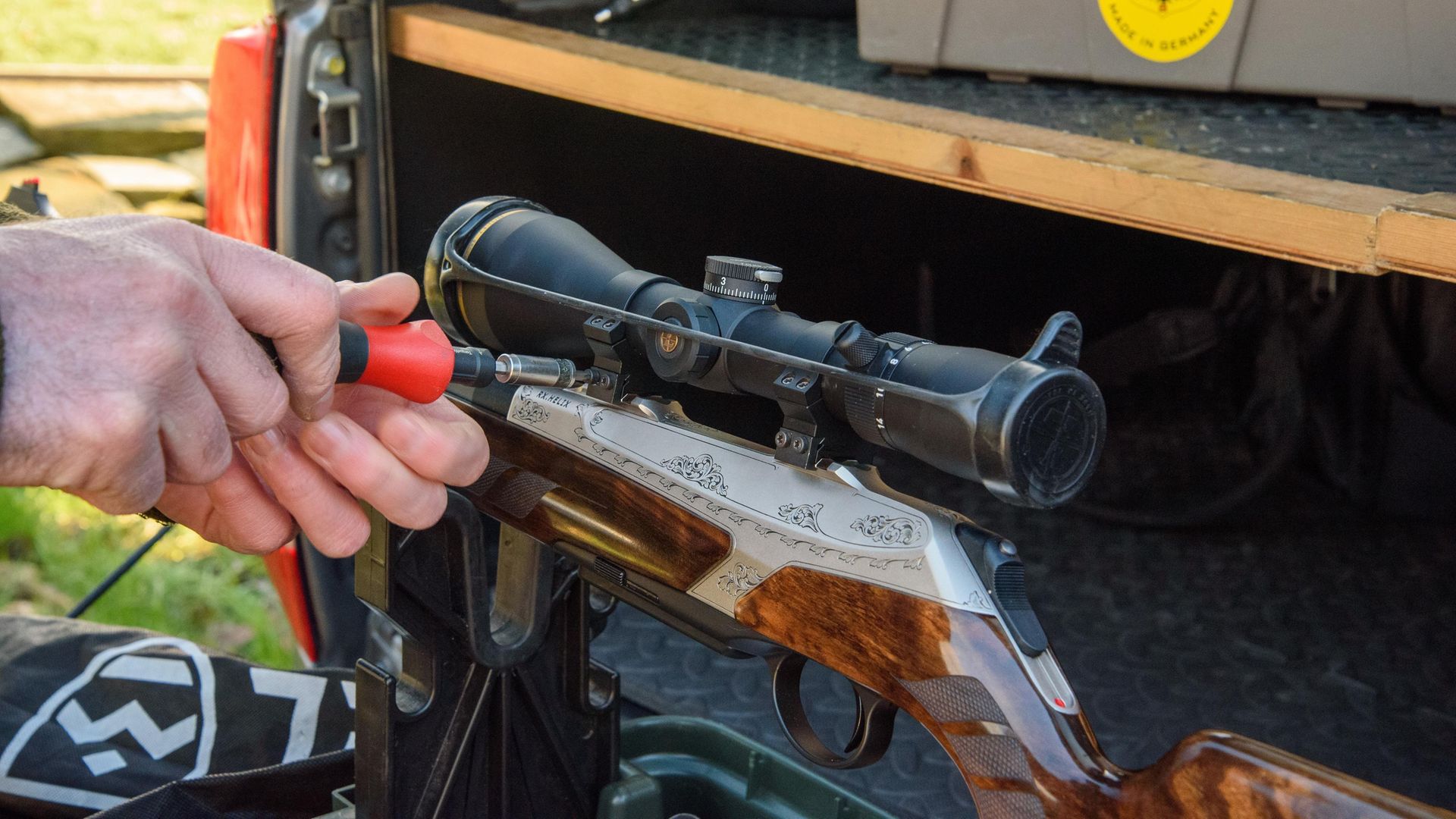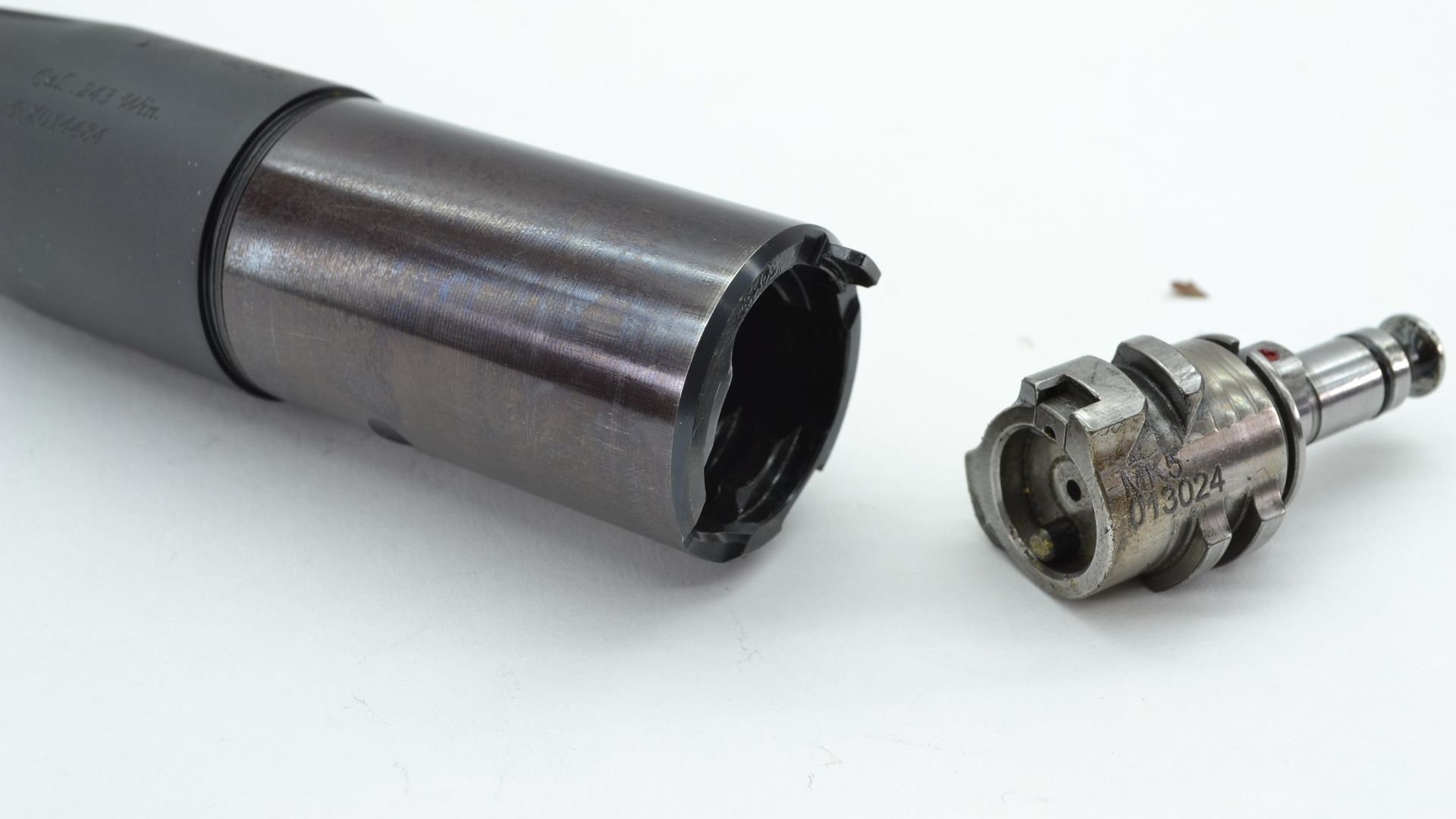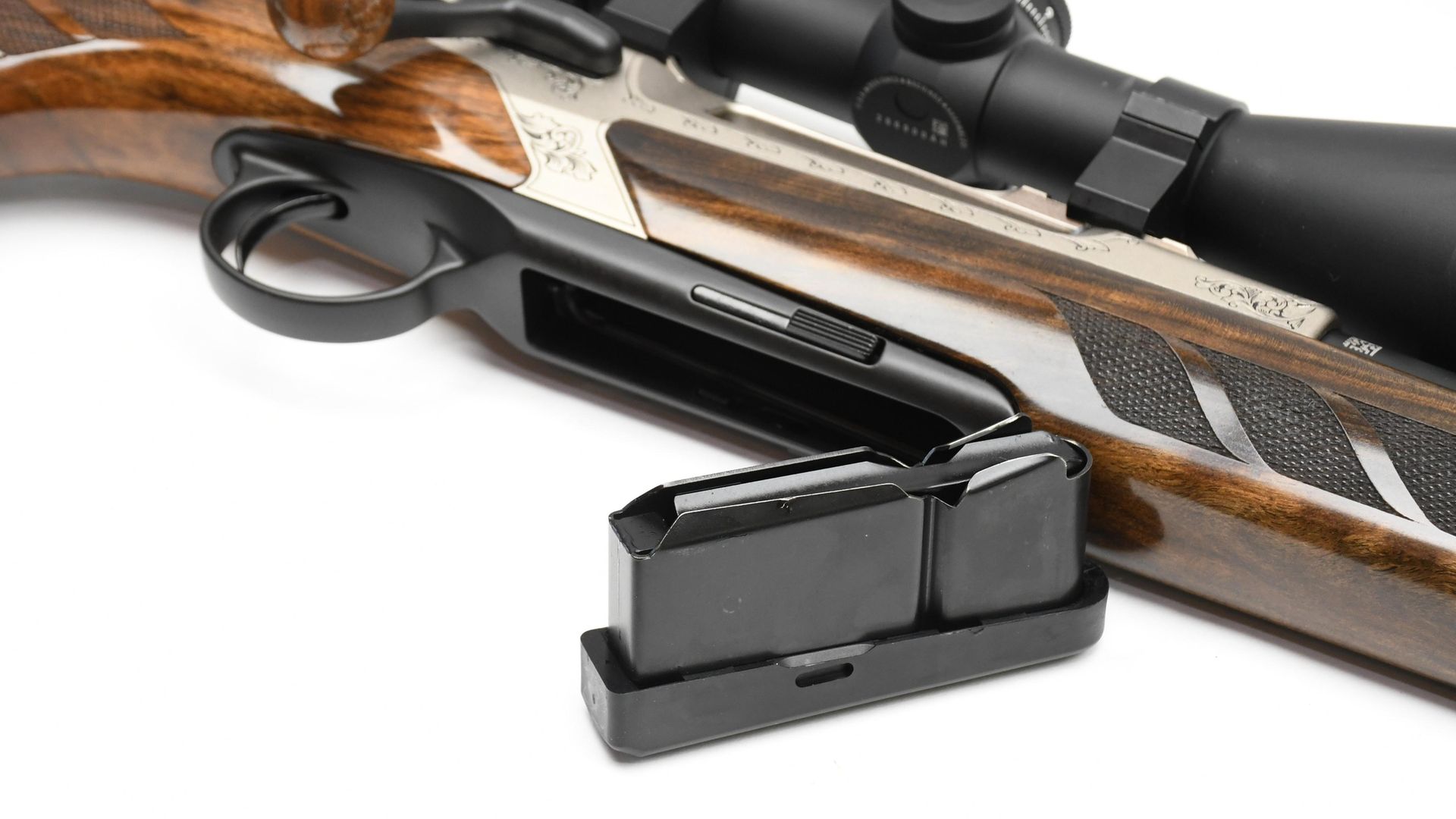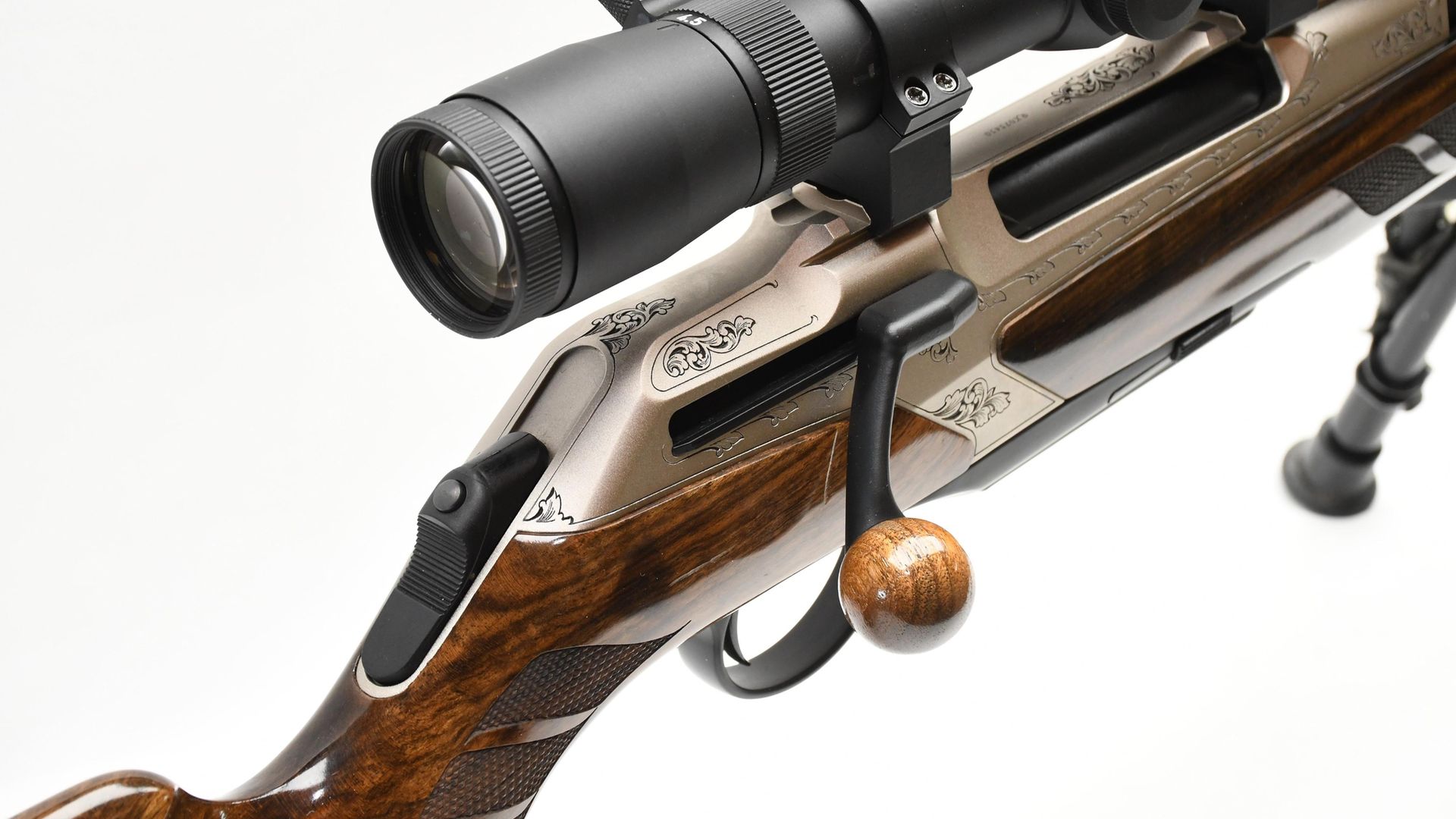It might look the business, but how does the Merkel Helix Arabesque measure up against the best in the field? Chris Parkin finds out
 credit: Chris Parkin
credit: Chris Parkin
I like the fact that the Merkel Helix is an unusual design, and this grade 6 walnut version is a great contrast to the Alpinist synthetic hunting tool – or more technically ‘upright pistol-gripped speedster’. I also like the colour contrast between the black barrel, silver action and beautiful walnut, as well as the somewhat timeframe-defying use of the latest action design, resulting in a build that employs both very new and very old materials.
 credit: Chris Parkin
credit: Chris Parkin
Main features of the Helix Arabesque
This Helix Arabesque has a 17mm diameter black, hammer-forged barrel with removable foresight concealing a 15x1 capped thread for a moderator or brake. It’s a shorter barrel, at 20"/510mm for fast handling, and it’s hard not to imagine this straight pull in tight woodland operation on driven hunts, for which I have used multiple Helix variants over the past few years.
The barrels are interchangeable, along with the bolt heads, and to change them you simply slide off the forend with its underside release catch disengaged and drop the lever under the tenon. If the bolt is closed at this point, the head itself will come out, locked into the barrel (the receiver is not pressure bearing). Should the bolt be open, the head remains within the action on its carrier. The barrels just slide out and back in.
Which bolt head do you need for the barrel? Pop it in to reverse the procedure as dictated by the action format. Then just lift the lever, slot on the forend and you are ready to go. Merkel themselves suggest operating the lever two or three times and cycling the bolt to ensure that everything is back in relaxed comfort. Generally speaking I carry a fire-formed case to chamber when swapping barrels. Maybe I’m obsessive – or just habitual – but I get return to zero within 3cm at 100m on the Helix using this method.
So, on to more about the action. Well, it’s a straight pull and quite a different one. There is a 60mm long handle drooping away behind the right-side ejection port on the action, capped with a 25mm walnut ball to match the stock. To re-cock and reload the rifle, just pull it back and you will soon appreciate the mechanically geared system within that allows cases up to .300 Win Mag length to be cycled with just a 62mm bolt stroke. Of course, if you halve the travel of the handle, the laws of physics dictate that you double the effort required, but as long as the ammunition isn’t defective or disruptively overpressure, everything works well.
 credit: Chris Parkin
credit: Chris Parkin
The carrier within rotates the bolt to unlock it and offer primary extraction. It’s not the strongest system in the world, and on occasion you certainly don’t want to be too delicate as some strength and speed is beneficial, but in the heat of the moment you don’t seem to notice. It is a little harder to operate the rifle as quietly as a conventional turnbolt when stalking, but not impossible and familiarity teaches the ability to operate it with just enough oomph.
One great benefit is that regardless of your nose size or head position there is no external rear bolt shaft emerging from the action and travelling towards your face. This helps you to keep your head in place on the stock as you cycle through the three rounds in the supplied single-column steel magazine, perhaps even after an initial plus-one in the chamber first. Larger magazines are available, and this is a fast gun. I have hunted boar with them on several occasions, one of which really did require me to shoot as fast as I could, and it’s hard to say I don’t have fond memories of the Helix used ‘in anger’.
The mags are a fast swap over, with twin release buttons spanning the underside well. The trigger is also mechanically proficient, with a pull of just 722g/25oz. With a crisp single-stage operation befitting a fast fire rifle, you won’t necessarily have the time or patience to squeeze quite as delicately as you would in prone use or as a well-supported stalking rifle. That is not to say that it fails in the latter task, but I just feel it is focused more on the former.
 credit: Chris Parkin
credit: Chris Parkin
Finer details of the Helix Arabesque
Another great modernistic contrast that seems at odds with an engraved action and grade 6 walnut stock are the twin Weaver bases machined as part of the steel receiver for scope mounting. As my regular readers know, I like the Weaver/Picatinny systems, and can’t fault them being used here. It may contrast with the walnut, but they are mechanically modern and intelligent for secure, worry-free and repeatable scope mounting with easy-to-source rings, whatever your scope size.
Returning to the action, it’s a bright silver finish with delicate, tasteful engraving. It’s enough to state ‘I’m here’ without being quite as overwhelming as some European designs. Is this a gun for me? No, it isn’t. I’m not particularly attracted by engraving, either aesthetically or financially, but when it comes to walnut on a fine European hunting rifle with mechanical ingenuity, I can’t help but smile. For starters, the ergonomics are well-suited to iron-sight use (the supplied ones are windage and elevation adjustable with fluorescent glowing dots), yet its shape works well with mid-sized sporting optical sights. It’s perfect for a low-level red dot if that’s your preference. But for me, for driven shooting like boar, I prefer a 1-4 or 1-6 optic, and these usually have smaller objectives that will remain seated low.
The comb shape is tall and slender, just right for cheekbone interaction without lateral jaw displacement. With a 14.25"/360mm length of pull, it’s unfortunately just the right size for me so I’m going to like it, and reach-to-trigger is excellent, with a large guard for gloved fingers in the cold. The radiused grip allows your hand position to vary slightly more than it would with a thumbhole, so it’s generally more accommodating for different hand sizes and finger lengths.
 credit: Chris Parkin
credit: Chris Parkin
The capped pistol grip has minimal palm swell and feels hand-filling without any undue bulk. Merkel don’t offer a left-hander but this rifle, although mechanically very right-handed, is certainly equally comfortable when being shot from the other shoulder. With a medium radius the grip performs well, offering the fast handling of a straighter grip like a sporting shotgun yet giving a bit more security for the sometimes deliberate aiming precision of a rifle. Importantly, though, your fingers flick straight off the front/side and up to the right to grasp the low-mounted bolt handle’s ball tip immediately for that fast reload, the pressure of which is impressed directly towards your shoulder. However, you won’t appreciate the speed so much on this short-action gun as sometimes, as I mentioned before, you do need to use a bit of force on the handle.
Chequering here and on the forend adds grip and some styling without excessive fuss. The forend also allows plenty of hand space without directly interrupting the barrel’s harmonics with your thumb or fingers applying pressure. Access to the de-cocker is similarly unobstructed on the tang – forward to cock/fire the action, dropped rearward for safe, which also entirely relieves firing-spring tension. A slight forward pressure will allow the bolt handle to open the action in this scenario, which is intuitively simple and safe for carriage or the often long waits in the forest, listening for every twig to crack, when the mind can easily wander away from the gun’s condition.
Studs are fitted fore and aft for a sling. The front one is on the tip of the forend, so ignore the bipod in the photo; it’s just balanced for position. Sliding the rifle from the shoulder and lifting it to firing position is fast, and without a moderator just that little bit less clumsy. During carry, the sleek shape of the rifle enables it to lie flat on your side/shoulder or even across your back, with little in the way of a bolt to dig into you. I would also recommend that it be locked shut and de-cocked. One factor with the Helix worth considering is that is it difficult to strip for cleaning. That’s really a workshop job to be reserved for if you get mud and debris in the receiver.
I dare say the grade 6 walnut version may lead a more delicate, cautious life than a stalker’s gun, which would be used in all weather conditions and dragged through foliage and damp when you’re crawling. Yet nobody ever plans to drop a gun, and we all need to consider worst-case scenarios when out hunting.
 credit: Chris Parkin
credit: Chris Parkin
Shooting the Merkel Helix Arabesque
Accuracy wise, with irons, this rifle is not a group shooter. It’s a hunting rifle, but with optics onboard, the quality hammered German barrels have no performance problems and can print cloverleaf groups. I have used the Helix in .243, .308 and multiple .30-06s (my absolute favourite) and here is where you most appreciate the walnut. The natural balance of the gun midway along its slightly longer action, coupled with the natural harmonics and recoil damping effect of the timber, is still something polymers can’t offer. Laminates are too dense/hard, and only very well specified and hand-laid carbon fibre can get close.
Why is the .30-06 my favourite? I simply love the way its long case feeds and it performs so easily with 180gr bullets, never feeling the need for the excessive pressures that can trouble extraction.
If you like the look of it, this Helix certainly seems to fit the bill for less aggressive hunts – and it will always draw attention.
Tech specs
Calibre: 308 Winchester
Weight: 3.05kg/6.72lbs
Barrel length: 510mm/20” 17mm diameter
Twist rate: 1-10”
Overall Length: 1075mm/42.25”
Magazine capacity: 3+1
Trigger: Single stage, 722gr/25.5oz.
Comes with: Iron sights, Screwcut 15x1 at muzzle for sound moderator, integral Weaver scope mounts
Available calibres: 222/223 `Mini,` 243/6.5x55/270/7x64/308/30-06/8x57/9.3x62 `Standard` 7mm Remington/300 Winchester `Magnums’
RRP: Merkel Helix Grade 6 Arabesque in 308 £5500
Contact: Viking Arms and Leupold optics